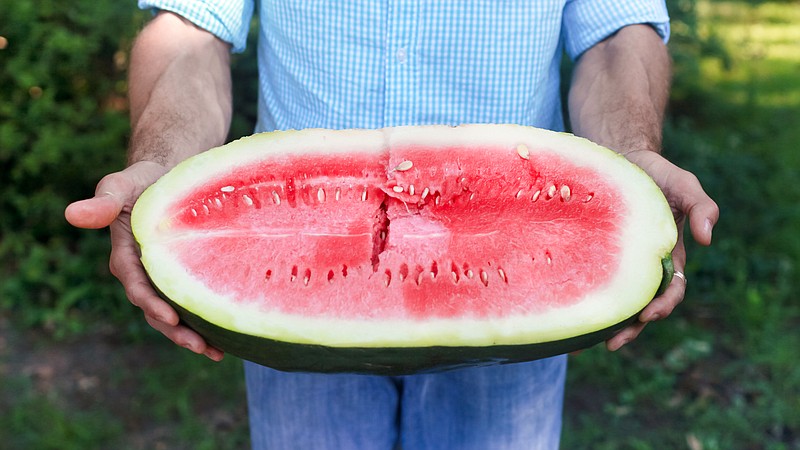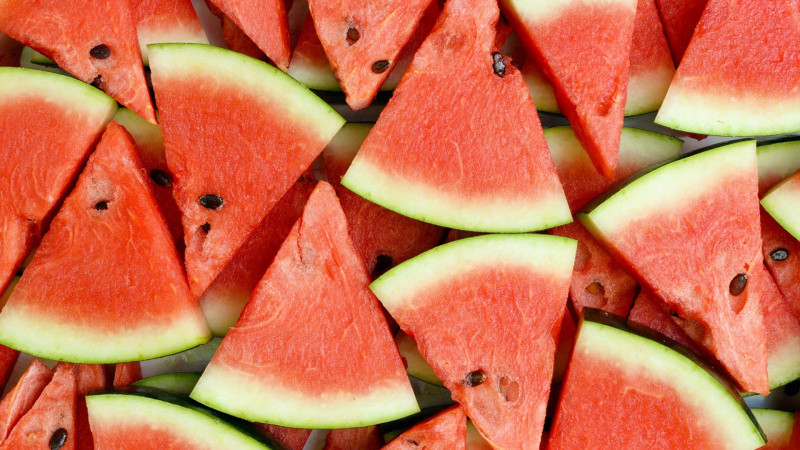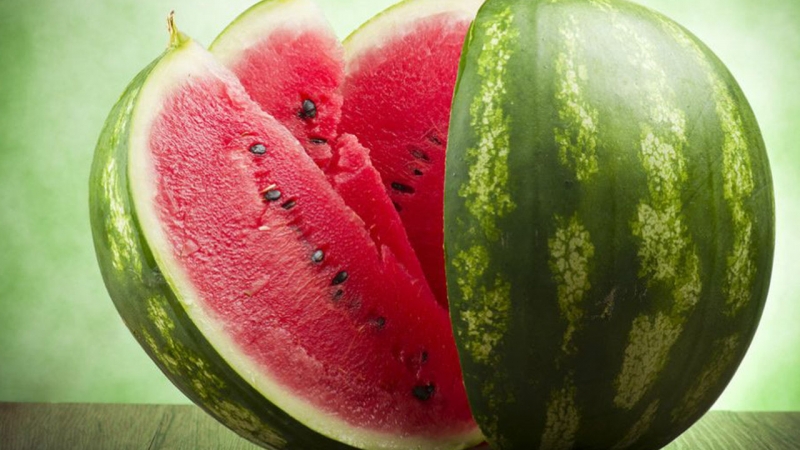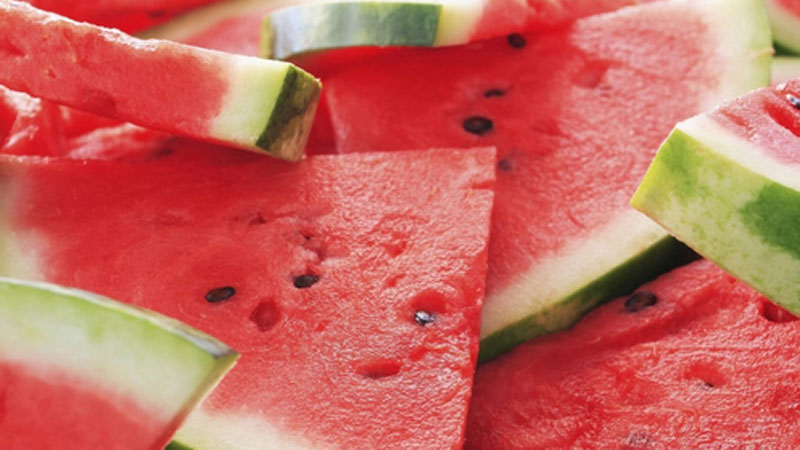Is it possible to eat watermelon with cholecystitis and pancreatitis
Therapeutic nutrition for cholecystitis creates normal conditions for the accumulation of bile and its release into the small intestine, serves as a good prevention of relapse. The main goal of the diet for pancreatitis in the acute period is to stop the production of pancreatic juice, which is achieved by fasting and adherence to strict bed rest. Even exposure to the sight and smell of food is undesirable. After the attack subsides and the pain subsides, they gradually expand the diet, include new foods, increase the amount of food and its calorie content.
During the period of remission, fresh vegetables and fruits, including watermelon, are allowed. It is rich in vitamin A, ascorbic acid, lycopene, pectins, calcium, sodium, magnesium and other chemical components necessary to ensure the full functioning of the digestive system and the body as a whole. However, the fruit is not useful for all diseases.
In the article, we will consider whether it is possible to eat watermelon with cholecystitis and pancreatitis, the rules and norms of use in the acute / chronic period, contraindications, precautions.
The content of the article
The benefits and harms of watermelon
Watermelon contains a large amount of biological substances important for the human body... Vitamin A in recommended doses slows down the aging process, stimulates tissue renewal and growth, nourishes and moisturizes the skin. It is a powerful antioxidant that normalizes metabolism, prevents the formation of cancer cells, regulates the synthesis of hormones, and creates favorable conditions for the full functioning of the immune system.
Lycopene in the fruit pulp performs an antioxidant function, neutralizes dangerous free radicals. With an insufficient content of lycopene, the risk of developing cardiovascular diseases, cancer of the prostate, lungs, and stomach increases.
 Vitamin C has a general strengthening effect on the walls of blood vessels, increases their density and elasticity, increases endurance and performance, improves the functioning of bone and connective tissues. A deficiency of the substance puts the immune and endocrine systems, heart, blood vessels, and digestive organs at risk.
Vitamin C has a general strengthening effect on the walls of blood vessels, increases their density and elasticity, increases endurance and performance, improves the functioning of bone and connective tissues. A deficiency of the substance puts the immune and endocrine systems, heart, blood vessels, and digestive organs at risk.
Watermelon is recommended for people who follow the figure or want to lose weight. The presence in the composition of plant fiber enhances intestinal peristalsis, normalizes defecation and stool consistency, relieves constipation.
reference... Fiber, like a sponge, cleanses the digestive tract of various kinds of toxins and toxins, stimulates metabolism, accelerates the process of breaking down fats. Getting into the stomach, pectin fibers swell, take up free space, which is why the feeling of satiety remains for a long time, there is no need for additional snacks.
Watermelon has a beneficial effect on eyesight, hair and nails, reduces muscle pain, inhibits inflammation in the body, increases urine flow without creating additional stress on the kidneys. Calcium in the composition is important for the formation and development of bone tissue, takes part in the mineralization of teeth, neuromuscular transmission, blood coagulation processes. Folic acids improve blood formation. Magnesium and potassium support the nervous system. Silicon stimulates collagen synthesis.
Advice! You should not buy a watermelon earlier than August, since the time of their ripening is closer to autumn.Early products are often grown with added nitrates, and the consumption of such watermelons is fraught with poisoning.
Chemical composition
Watermelon pulp is 92.6% water. The edible part of the fruit contains chemical components such as:
- pectin;
- easily digestible sugar (glucose, fructose, sucrose);
- starch;
- alkaline substances;
- vitamins: retinol, beta-carotene, thiamine, riboflavin, choline, pyridoxine, cobalamin;
- vitamin PP;
- ascorbic, pantothenic, folic acid;
- niacin;
- macroelements: chlorine, sulfur, phosphorus, calcium, potassium, magnesium, silicon, sodium;
- trace elements: boron, iron, vanadium, aluminum, iodine, lithium, cobalt, manganese, copper, rubidium, molybdenum, nickel, selenium, fluorine, strontium, zinc, chromium;
- essential and non-essential amino acids;
- saturated and polyunsaturated fatty acids.
KBZHU
Watermelon is classified as a low-calorie food: its energy value is 27 kcal per 100 g. The pulp contains practically no fat (0.1 g), but is saturated with carbohydrates (5.8 g). Proteins in the composition of 0.7 g.
Is it possible to eat watermelon with cholecystitis
 The opinions of experts on this matter are ambiguous. It is obvious that in the acute period of the disease, watermelon, like other fruits and vegetables, is categorically contraindicated.
The opinions of experts on this matter are ambiguous. It is obvious that in the acute period of the disease, watermelon, like other fruits and vegetables, is categorically contraindicated.
In other cases, the usefulness of the fetus depends on the causes of cholecystitis, general health, and the presence of concomitant diseases.
Points for and against
When the gallbladder is damaged, many foods are contraindicated, which is why the body may experience a deficiency of vitamins, micro- and macroelements that are important for the body.
The pulp of watermelon fruits partially reduces the need for ascorbic acid, retinol, magnesium, calcium, potassium, iron and other biologically active components. Watermelon in moderation acts as a diuretic: it increases the rate of urine formation, reduces the fluid content in tissues and cavities. At the same time, the fetus does not create an additional load on the kidneys, which helps to avoid the formation of salt stones in the organs of the urinary system.
Watermelon in moderation acts as a diuretic: it increases the rate of urine formation, reduces the fluid content in tissues and cavities. At the same time, the fetus does not create an additional load on the kidneys, which helps to avoid the formation of salt stones in the organs of the urinary system.
During the period of remission, watermelon is used as a natural choleretic agent. It enhances the formation of bile in the body and prevents its stagnation, activates the motor and secretory functions of the gastrointestinal tract, has a slight laxative effect and improves digestion in general.
The components in the sweet fruit have a beneficial effect on the condition and functionality of the digestive tract: they stimulate intestinal motility, normalize metabolic processes, cleanse the intestines from toxins and toxins.
The opinion that watermelon should be excluded from the diet of patients with cholecystitis is due to the presence of ascorbic, pantothenic and folic acids in its composition, which irritate the mucous membrane. Such an effect can cause an exacerbation of the disease, cause a new attack of pain.
Watermelon can harm the body in the presence of concomitant diseases of the gastrointestinal tract: for example, gastritis with high acidity. The edible part of the fruit is acidic, which leads to an increase in acidity in the stomach. High pH is accompanied by heartburn, belching, discomfort and heaviness in the stomach, diarrhea or, conversely, constipation, bloating.
For reference. The increased acidity of the stomach is considered as a provoking factor of peptic ulcer disease, gastritis and duodenitis of the chronic course, gastrointestinal reflux.
Rules for use with cholecystitis

Let's start with how to choose the right watermelon. Better to buy melons near the field where they grew, or in the market. Ideally, the fetus should weigh 6-10 kg. Larger berries can be grown with the addition of nitrates, while small ones have not yet ripened.
There are general rules for the use of watermelon with cholecystitis:
- the fruit should not be eaten in the morning on an empty stomach, since the acids present in the composition have an irritating effect on the mucous membranes;
- the fetus is introduced into the diet gradually, starting from one middle lobule, subsequently increasing the rate;
- you can not drink it with water, milk, or other liquid, since watermelon already contains 92.6 g of water in 100 g of pulp;
- in case of deterioration in general health, the occurrence of local allergies, the product is excluded from the diet and the state of health is monitored;
- melons are bought only during their ripening in natural conditions: in the second half of August - mid-October;
- for diseases of the digestive system, it is not recommended to consume watermelon daily;
- after the pain fades away you can make juice from a sweet fruit: it is easier and faster absorbed in the stomach;
- in the case of chronic cholecystitis, unloading with a watermelon can be performed once a week. During the day, consume 1.5 kg of pulp, dividing it into 5-6 doses;
- the optimal time for watermelon is a snack between main meals.
Most often, the berry is consumed fresh. Used in the diet as an independent product or as an ingredient in fruit salads, canned. The edible part is processed into juice, which can then be evaporated to the density of honey.
Usage rates
Despite the usefulness of the fruit, it should not be consumed in large quantities. The average daily allowance for an adult varies from 300 g to 1.5 kg (depending on the presence of other products in the diet, concomitant gastrointestinal diseases, contraindications). At a time, they eat no more than 200-300 g of pulp.
Watermelon during exacerbation of cholecystitis
 Watermelon, like other vegetables, fruits and berries, is categorically contraindicated within 7-10 days from the moment of the first symptom of the disease, until the pain is stopped, and during the exacerbation of the chronic form.
Watermelon, like other vegetables, fruits and berries, is categorically contraindicated within 7-10 days from the moment of the first symptom of the disease, until the pain is stopped, and during the exacerbation of the chronic form.
In the first days of inflammation, fasting is performed to maximize sparing of the mucous membrane. You can drink water, weak tea, rosehip broth. On the 3rd day, a strict diet is prescribed that excludes products with chemical and mechanical irritation.
Patients are on such a diet for 4-5 days. Further, grated porridge in water, soups, a little boiled meat, white crackers are introduced into the diet.
As overall health is restored and pancreatic function normalizes, limited quantities of fresh vegetables and fruits, including watermelon, are allowed.
In chronic form
With chronic cholecystitis, you can eat watermelon in moderation, but only during remission. With regular and dosed use, the fetus helps to restore the function of the biliary system, increase the rate of urine formation.
Together with this, gall stones are removed, the outflow of bile is normalized, the stagnation of which is of primary importance in the development of pathology.
Is it possible with pancreatitis
Since diseases have similar causes and symptoms, nutrition has a lot in common. Any food is contraindicated in patients in the acute period of pancreatitis. After the pain subsides and the general state of health stabilizes, it is allowed to include the edible part of the watermelon in the diet in moderation.
Contraindications
The fruit is categorically contraindicated in case of individual intolerance to the component (s) of the composition.
Relative contraindications include:
- gastritis with high acidity;
- peptic ulcer of the stomach and duodenum during an exacerbation;
- the presence of large salt stones in the urinary system.
Precautions
Watermelon, like other vegetables and fruits, must be consumed seasonally during their ripening in nature. It is important to pay attention to the pulp: the purple color is a sure indication of the presence of nitrates. The beneficial pulp will be sugar and grainy, without yellow streaks. If it is smooth and even, you cannot eat this watermelon. A quality fruit has a tail that is not overdried, but not green either, there is a small yellow spot on the side.
 In cases where, after consuming watermelon, the general health condition has worsened, local signs of allergy appeared in the form of redness, rashes and peeling on the skin, new bouts of pain,the fetus should be discarded for a while. If after this the condition has not stabilized, medical attention is needed.
In cases where, after consuming watermelon, the general health condition has worsened, local signs of allergy appeared in the form of redness, rashes and peeling on the skin, new bouts of pain,the fetus should be discarded for a while. If after this the condition has not stabilized, medical attention is needed.
Read also:
Whether plucked watermelons ripen at home.
Step by step instructions: how to dry a watermelon in an electric dryer.
Conclusion
Diet for pancreatitis and cholecystitis plays an important role in all periods of disease. Watermelon is included in the list of permitted foods, but its pulp is consumed in moderation and only without aggravation. During the period of remission, quality melons and gourds, like other fruits and vegetables, will be beneficial for health.
The unique properties of watermelon help relieve puffiness, promote the elimination of excess fluid and salt stones, normalize metabolic processes, reduce bile stagnation, activate the digestive tract and cleanse the body of toxins and toxins. To be sure of benefit product in the case of a specific patient, it is necessary to exclude possible contraindications and consult a doctor.